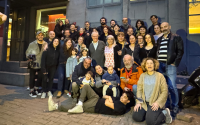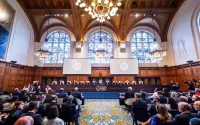28 May 2008The New York Times
New York City Mayor Michael R. Bloomberg discussed the disconnect between science and society in the opening address on Wednesday morning at a novel event, the inaugural World Science Festival.
The four-day conclave — involving panels, dance performances, juggling acts and other presentations dealing with science — was conceived by a team led by Brian Greene, the physicist and science popularizer, as a way to celebrate science. But it is clearly also aimed at restoring science to a position of respect and prominence in society.*
After an opening quip about his scene in "Sex and the City" ending up on the cutting-room floor, Mr. Bloomberg framed his speech around "the tragic lag between what we know and what we do."
He focused on smoking, reviewing how the tobacco industry spent decades sprinkling doubt into discussions of science showing links between smoking (and secondhand smoke) and cancer and other illness. While many wealthy countries have moved to constrain and tax smoking, the world, Mr. Bloomberg said, is still on a path toward a billion smoking-related deaths in this century.
He then shifted to climate and energy, describing how science has been distorted not only by industries and anti-regulatory groups, but also political operatives working within government agencies. The latest example, Mr. Bloomberg said, was the ongoing politics-driven push to subsidize ethanol from corn.
He said he learned a dictum in early jobs on Wall Street that can apply far beyond the realm of finance: "In God we trust. Everyone else, bring data."
Then the first panel began, comfortably far from the realm of policy relevance, with a discussion among leading scientists of dark energy, the nature of consciousness, and the fate of the universe, led by Alan Alda.
[* Full disclosure: I'm running a panel (pro bono) on Saturday night about providing adequate energy to a growing human population on a finite planet.]
For those who are interested, here's the full text of Mr. Bloomberg's speech, as released by his office prior to delivery:
Thank you, Brian. And thank you, President Bollinger, for hosting us all today. Good morning everyone. Let me welcome all of you to the first annual World Science Summit, which kicks off the World Science Festival.
Last week, when I gave the commencement address at the University of Pennsylvania, I stressed the strong connection between immigration and innovation in making America great. In that spirit, it's an honor to extend a very warm welcome to Fred Kavli, who immigrated to our country from Norway more than 50 years ago, and whose innovations in electronic sensors revolutionized our aerospace and automotive industries. I'm delighted that he has chosen New York as the place to announce the winners of the first annual Kavli Prizes of $1 million each in astrophysics, neuroscience, and nanotechnology.
My undergraduate degree happens to be in engineering. And even though I was the kind of student who normally made the top half of the class possible, when I first saw this Summit on my schedule, I thought this might be the right occasion to dust off my own research findings on the molecular structure of immune system interactions, the rigidity of single-strand DNA and my insights into the causes of failed stars. But my dog ate my paper, and wouldn't you know it, my lab coat is still at the cleaners. So I'll leave that sort of thing up to the real experts: the scores of world-class scientists – including the ten Nobel Prize winners here this morning – who will use this festival's programs to introduce the thrills and wonder of scientific discovery to everyone.
This Science Festival coincides with the opening of a certain movie set in New York about four independent and glamorous women. By the way, I was originally supposed to have a part in Sex and the City, but my scene wound up on the cutting room floor. It turned out that they wanted more sex and less city. That's fine. Their loss.
Today, I want to talk about a phenomenon just as exciting, just as cool and just as cutting-edge. I call it: 'science and the city.' Because in addition to being a center of finance, entertainment, fashion, and culture, New York is also a world leader in scientific research, and this World Science Festival will really put the spotlight on that. Thanks to Brian, Tracy Day, and everyone associated with the Festival, it's also going to use theater, dance, film, and music to make science in our city sexy. And that sexiness is also going to be on spectacular display in New York this summer, thanks to internationally recognized artist Olafur Eliasson's monumental Waterfalls public art installations along our East River waterfront.
The strength of science and our city starts with our wealth of scientific talent and resources – the best in any American city. The city is home to more than 30 distinguished academic, medical, and research institutions. More than 120 of the nation's Nobel laureates have studied and worked in New York City. Two of them – Sir Paul Nurse and Doctor Harold Varmus – direct two of the world's greatest medical research facilities, located in Manhattan: Rockefeller University and Memorial Sloan-Kettering Cancer Center, respectively. In fact, nearly six years ago, I was honored to have Doctor Varmus at my side when we testified before New York's City Council, urging them to ban smoking in all bars and restaurants in our city, a subject I'll come back to in a few minutes.
Science in our city also puts New York on the cutting edge in the study of climate change. Columbia University's Earth Institute and its Lamont-Doherty Earth Observatory are world leaders in understanding and addressing global warming. And scientists associated with the Center for Environmental Research and Conservation – a consortium of five major institutions based in our city – are collectively doing vital research on climate change in more than 60 nations worldwide. Their efforts are shrinking the still enormous gaps between what we know and what we don't know on these important subjects.
But vast as those gulfs are, they're dwarfed by another one. And that is the tragic lag between what we know and what we do. For example, in the 1950s, the head of the American Cancer Society and other respected scientists were already linking smoking and cancer. And as early as the 1970s, researchers predicted that increased greenhouse gas production was accelerating global warming, with the potentially catastrophic consequences that are playing out now, all over the world. Yet policy makers failed to heed these warnings. Why? Far too often, it's because of what I call 'political science' – the willingness to disregard or suppress scientific findings when they don't conform to a pre-determined political agenda.
Today, we're seeing the tragic economic and environmental consequences of such political science writ large in our nation's deeply misguided policies concerning the world's two most fundamental needs: food and fuel. The food shortages and riots that have wracked the world in recent months, from the Philippines to Egypt to Haiti, have starkly dramatized the moral bankruptcy inherent in our government's continued subsidies for the production of corn ethanol.
For years, politicians have hailed corn ethanol as the answer to climate change. It was all so simple. Instead of requiring fuel efficiency, or funding mass transit, we could have our cake, or in this case corn, and drive cars with it too, and, in the process, divert millions of tax dollars a year to farm states. The only problem was this policy wasn't based on science. For years, research has questioned the environmental benefits of corn ethanol, and now widespread production of corn ethanol has turned out to be an environmental and economic calamity. It not only imperils the world's climate by encouraging the widespread destruction of climate-crucial forests and wetlands, but also drives up the cost of one the world's most important cereal crops.
I raised objections to corn ethanol last November, in testimony to the House Select Committee on Energy Independence and Global Warming. And in recent months, there's been an increasing, if belated, emerging consensus on having a bio-fuel policy that is good for the environment, not just the special interests. Congress can do that by turning from the folly of corn ethanol to the merits of using other more efficient bio-fuels, including sugar-based ethanol. Right now we're taxing sugar-based ethanol at 54 cents per gallon while we are subsidizing corn-based ethanol at 45 cents per gallon, even though sugar-based ethanol is cheaper and producing it generates less carbon dioxide.
That's special interest politics, plain and simple. And if our elected officials in Washington are serious about fighting special interests, they should lift all tariffs on more efficient biofuels, including those produced from sugar.
I think it's very interesting that last November, Florida Governor Charles Crist – the governor of the state that produces more sugar cane than any other, and about a fifth of all American sugar – visited Brazil and proposed ending America's tariff on sugar ethanol from that country. It may seem counter-intuitive for a governor to appear to undercut one of his state's biggest industries. But real leaders can see the bigger picture beyond the narrow and immediate concerns. And the Governor was right on the money as well. Importing sugar-based ethanol from Brazil will create a market for that product in the U.S. – and that will produce a sweet new market for Florida sugarcane growers, too.
That makes sense, for Florida and for America, and a far sight more sense than the status quo. Because think about it. Congress wants to cut the gas tax, which any economist will tell you won't save consumers money at the pump. But they refuse to pull agribusiness's snout out of the public trough, something that would save Americans money, and save lives around the world. That's political science at its worst. And it's akin to the political science that threatens our health and safety, by undermining the supposedly impartial regulatory bodies set up to protect us, that often obstructs basic research into disease and disability, and that rationalizes inertia when what we need is action.
When such political science triumphs, both politics and science suffer. So does our entire society. But it's important to remember that politics and science don't have to be antagonists. In fact, America has a long political tradition of supporting science. It's one we should be proud of and embrace. Franklin, Jefferson, and other of our nations' founders weren't just statesmen; they were also respected scientists. And from the Lewis and Clark expedition to the establishment of NASA, our government has long actively encouraged scientific investigation and innovation, wherever they might lead.
We can reclaim that heritage if we show the independence and integrity to look at the facts, to embrace what science tells us regardless of the consequences, and not be cowed by special interests. And in the spirit of 'science and the city,' let me describe how we've done that in New York in the vital areas of public health and climate change.
When we came into office in January 2002, we quickly identified tobacco as the leading cause of death in our city, implicated in 10,000 completely preventable deaths every year. So we made cutting down on smoking the city's number one public health priority.
In my first job on Wall Street I learned: 'In God We Trust. Everyone else: bring data.' What's true in high finance is true in public health, too. That's why we began with collecting baseline data, and why we've followed that up with ongoing surveys of our city's population. We know from science that second-hand smoke also kills, including second-hand smoke in workplaces such as restaurants and bars. So in 2002, we passed pioneering legislation outlawing smoking in the workplace. It wasn't easy; there was a lot of opposition. And marching in neighborhood St. Patrick's Day parades back then, I got a lot of one-fingered waves. (I don't think they were telling me that I was number one in their books.) But today, that law has become second-nature for New Yorkers, and I can't tell you how often workers in restaurants have thanked me for what we did to protect them.
We took other steps, too. We raised the City's tax on cigarettes steeply. Cigarettes prices make little difference to adults; they'll stop eating before they give up smoking. But teenagers are particularly sensitive to such higher prices, and they have played a bit part in discouraging teen smoking. We also mounted hard-hitting public information advertising campaigns, and greatly increased smoking cessation programs.
Here are the results. Today, smoking in our city is down more than 20 percent. We estimate that has prevented at least 100,000 premature deaths. Also, smoking among teenagers is down 52 percent. Just a few years ago, nearly one in four teens smoked. Today, it's one in 12. That's a very hopeful trend that is going to save even more lives in the years ahead. It sets an example for cities across the nation and countries around world. Six years ago, very few U.S. cities had laws banning second-hand smoke. Today, most Americans live in cities and states governed by them. Our nation as whole hasn't yet had the courage to follow suit, but nations that have include Italy, Norway, New Zealand, the UK, the Republic of Ireland, and Turkey, to name just a few. That's great news, because we're in a global race to save as many of the one billion people who, if we don't take urgent action, will be killed by smoking this century.
We're in another deadly global race too – one against global climate change. As with tobacco use, the science here is now incontrovertible. To manage New York City's impact on global warming, first we had to measure it. So two years ago, we decided to do what no one had ever done before: measure the size New York City's carbon footprint. We learned that we produce some 58 million metric tons of carbon dioxide every year and that this carbon footprint was growing. In fact, it was on course to increase by some 27 percent by the year 2030. But we didn't just find out the size of our problem, we also learned how to attack it.
I believe strongly in leading by example. That's why last October, I signed an Executive Order directing City agencies to shrink City government's carbon footprint by 30 percent by the year 2017 and to start acting now. To do that, we're committing 10 percent of our annual energy costs – equal to roughly $80 million a year – to reducing City agency production of heat-trapping gases. We've taken major steps to reduce greenhouse gas emissions from autos; the world's largest yellow cab fleet is slated to go green by converting to hybrid or hybrid-equivalent power by the year 2012. We've focused on replacing old and heavily polluting power plants with newer, more efficient generators. We've taken steps to put New York in the lead in energy-efficient power co-generation. And we're on course to more than double production and use of solar power in New York City by this time next year.
That's not only going to shrink our carbon footprint; it's also going to take deadly pollutants out of the air we breathe. For New York, as for other great cities, cleaner air and a greener environment go hand in hand. As with tobacco control, this is another area where 'science and the city' is going global – and New York City is leading the way.
As we become a more urbanized world, we'll also certainly become a more science-friendly world. The leaders of the world's cities are the great pragmatists on the world's stage. Our concern is protecting the health of our people and increasing the wealth of our economies. So we're interested, not in ideology, but in results, and that makes us natural allies of science.
It's also true that 'science and the city' is a relationship as old as history itself. Cities have always been science-friendly. That was true in ancient Alexandria and Athens, true in the city-states of Renaissance Italy, and it's truer than ever in New York City today.
In medieval times, it was said that 'city air is freer,' because cities liberated people from the bonds of feudalism, unlocked human creativity, and fired human imaginations. Now 'science and the city' – scientists and city leaders – have the potential to make the air freer and healthier for everyone who inhabits our globe. Let's work together to make that potential a reality.
Thank you and have a great week in New York.






